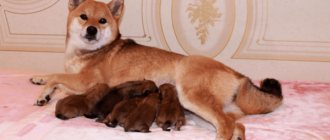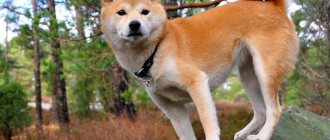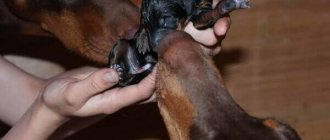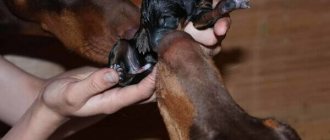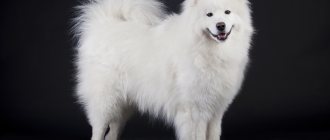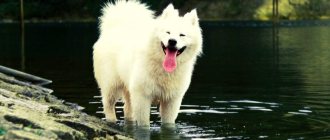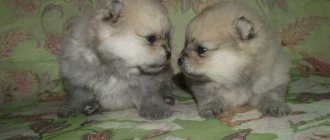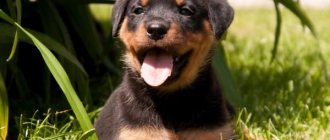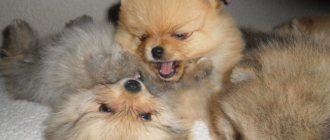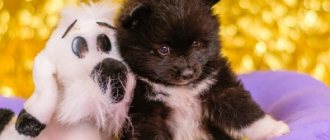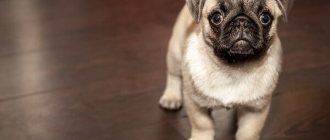The Samoyed is a medium-sized dog with long, thick white hair.
One of the most ancient breeds, it belongs to the Spitz-type dogs.
A friendly breed with an easy-going disposition.
Perfect as a companion or devoted friend.
What newborns look like in the photo, their sizes
Samoyed puppies are born weighing approximately 300 grams and 10-12 cm long . Their eyes and ears are closed, but they actively breathe, suck and try to crawl. At first, the puppies only eat and sleep.
Healthy puppies look dense and strong, barrel-shaped. They hang well on the nipple, look contented and can sometimes moan with pleasure.
Babies cannot do anything on their own except suck and move their head and paws.
The mother stimulates them from the first minutes of life. For bowel movements, cleansing and even for the first breaths, the bitch licks and nudges her puppies, thereby encouraging them to act.
In the first 7 days, puppies grow very quickly and their weight doubles.
At 10-14 days the eyes open, but the gaze is still poorly focused.
At 3-4 weeks, puppies fully master vision and hearing, begin to actively explore the world around them and are able to get to know and respond to the breeder and other animals.
Characteristics
The Samoyed husky in the photo is a common example of a dog's exterior. Samoyeds are very beautiful. The medium head is wedge-shaped, with a prominent forehead and a long, narrow muzzle that resembles a fox. The bite is scissor-shaped, the grip is strong, which allows the dogs to be hunters of small game.
The ears are fluffy even inside, erect. They have a triangular shape and are generally directed clearly forward, which makes the dog look attentive and focused.
A distinctive feature of dogs is their eyes. They look like black beads on a white fluffy background. The eyes look a little sly, as if slanted. This effect is achieved due to the black rim of the eyes - the mucous membrane is dark in color, and not white, like the rest of the body. Therefore, the Samoyed's gaze is always a little sly and smiling.
The average weight of a Samoyed husky is 25 kg, but males can weigh as much as 30. These are medium-sized dogs that are classified as Spitz. Height at the withers is about half a meter. The dog's body is short, with a dense, lean belly. The legs are straight, perpendicular to each other, strong and strong. Wide paws indicate that the dog walked through snowdrifts without difficulty.
Don’t be fooled by the airiness of Samoyeds—the dogs are muscular and strong. Their spine is strong, which allows them to withstand high loads. The movements of the Samoyed are light, smooth, as if floating. The fluffy tail is curled over the back.
The Samoyed's thick, fluffy coat requires careful and regular grooming.
Development of puppies up to one year by month
| Month | Size, cm | Weight, kg | Description |
| 1 month | 10-12 | 0,3-1,0 | Puppies are born. They have sucking reflexes and move their paws and head. By two weeks, the eyes and ears open. At 3 weeks, teeth begin to emerge. By the 4th week, they begin to fully see and hear, and actively become acquainted with the world around them. |
| 2 month | 15-20 | 3 | Continue socialization. At the age of 7-9 weeks, puppies are separated from their mother. This is the most appropriate moment; later it will be psychologically more difficult for the puppy. The new owner should recreate the conditions familiar to the puppy as completely as possible to make it easier for him to adapt. All members of the family should show care and attention so that the animal develops a sense of a pack, and not one owner stands out. By two months, some puppies begin to defecate in the same place. This age is also best for starting training. You can start with basic commands, “fu!”, “no!”, “place.” At 6 weeks the first vaccinations are given. |
| 3 month | 20-38 | 7 | Period of active movement. For proper mental development, a puppy needs active games. Since all the necessary vaccinations have already been completed, the puppy needs to be taken outside for a walk. New simple commands are added to the training. |
| 4-5 month | 35-40 | 9-11 | Time to change baby teeth. This period can be painful, so the dog may chew on things around it. For relief, you can give your puppy a large bone, a sterile hoof, or a pig's ear. The period of socialization continues. At this age, the dog will observe the owner's reaction to certain actions. It is important to take a firm stand and make it clear who is in charge. They teach all the necessary missing commands. |
| 6-8 month | 40-50 | 13-15 | The age at which a puppy transitions into the juvenile period. The dog has both adult and child behavioral forms. Bitches may have their first heat. |
| 9-12 month | 52-58 | 17-20 | Dogs stop growing. Males begin to raise their legs when urinating, which signals the end of their puberty. They show sexual activity, but are not yet ready for mating. The time of the next development of the psyche, the animal may become disobedient, trying to take leadership in the pack. |
Puppies nutrition
How many times to feed
The number of feedings a puppy depends on his age:
- at the age of 1-2 months - 6 times a day
- 2-4 months - 5 times a day
- 4-6 months - 4 times a day
- 7-12 months - 3 times a day
- after one year - 2 times a day
After purchasing a puppy, you should feed it the same as the breeder fed it. After adaptation to the new home, you can switch to another food.
You need to purchase two bowls - one for food and one for water..
It is better to place them on a stand where it is possible to adjust the height so that the dog does not develop curvature of the spine and deformation of the joints of the forelimbs.
To do this, it is necessary that the bowls are at or slightly above the elbows of the dog's front paws.
Water must be freely available at all times . The water needs to be changed daily.
Feed no more than 15 minutes . If the puppy indulges or does not eat, the food is removed and given again only at the next feeding. This way you can instill food discipline in your dog.
You should not feed your dog before a walk. There is a risk of gastric volvulus. After eating, the animal needs rest.
What to feed
You can feed puppies two types of food: ready-made dry or natural products . Each owner chooses the type of food at his own discretion, the main thing is that it is of high quality.
If it is dry food, then it should be premium. If the products are natural, then fresh and from proven sources.
Natural feeding requires the correct introduction of various foods into the puppy’s diet.
CAREFULLY!
You need to cook separately for your dog. Food from the master's table is strictly prohibited.
It is also important that the diet is balanced.
The diet should have the following ratio:
- 10-20 g of meat per 1 kg of body weight;
- 1-2 g of fat per 1 kg of body weight;
- 5-6 g of carbohydrates per 1 kg of body weight;
- 9-15% should be minerals.
What can you feed puppies?:
- Lean meat - veal and beef, poultry. Freeze for several days before eating. Served raw, cut into small pieces.
- Offal (kidneys, liver, lungs, udder, heart, tripe). Introduced into the diet from 6 months, given in boiled form.
- Dairy products (kefir, cottage cheese, fermented baked milk, yoghurts). Perfect for initial complementary feeding. Up to 6-7 months it is necessary to give highly calcined cottage cheese.
- Eggs. Once a week it should be added to dairy products, or given as an omelet.
- Fish. Sea or oceanic will do. You can give it raw, after first dousing it with boiling water and freeing it from the bones.
- Cereals. They are not the basis of the diet, but are necessary to replenish energy. Can be mixed with vegetables. Rice, buckwheat, millet and sometimes steamed rolled oats are allowed.
- Vegetables and fruits. Carrots, cabbage and zucchini can be given boiled, stewed or raw. Apples are sometimes given as whole toys.
Mineral supplements are given from 4 months . They should contain chondroitin and glucosamine, which have a beneficial effect on the cartilage tissue of the animal’s joints.
Menu for the week
| Day of the week | Breakfast | Dinner | Dinner |
| Monday | Cottage cheese | Buckwheat with fish | Stewed cabbage with chicken |
| Tuesday | Curdled milk or kefir | Rice with liver | Piece of fish |
| Wednesday | Cottage cheese or low-fat broth | Buckwheat with heart | Stewed beets with fish |
| Thursday | Boiled fish | Low-fat broth and boiled egg | Zucchini with chicken |
| Friday | Cottage cheese or kefir | Hercules with beef | Stewed pumpkin with rice |
| Saturday | Cottage cheese | Buckwheat with boiled turkey | Boiled beef |
| Sunday | Curdled milk or kefir | Rice with liver | Stewed carrots |
What vaccinations are needed?
Vaccinations are given by a veterinarian in the clinic or called to your home.
Anthelmintic drugs are given 10 days before vaccination . The puppy must be healthy.
It is recommended to use vaccinations from such manufacturers as MERIAL (Eurikan, PrimoDog), INTERVET (Nobivak), Fort Dodge Animal Health (Duramune MAX). The latter is the most modern and safe vaccine.
Vaccinations are given according to the following schedule:
- first - at 6 weeks
- second - at 8 weeks
- third - at 12 weeks
- simultaneously with the third or after 2 weeks rabies vaccination
- Vaccinate annually against leptospirosis, plague and rabies.
We must not forget about the anthelmintic before vaccination, otherwise the vaccinations will need to be repeated again.
Which dry food to choose?
When deciding to feed your puppy ready-made dry food, you need to choose premium and super premium food..
Economy class feeds do not meet the full requirements of a balanced diet and do not contain sufficient minerals and vitamins.
The following brands of food are suitable for nutrition: Hill's, Purina Pro Plan, Bosch, Eukanuba, Acana, Orijen, Royal Canin, etc..
Among them, you can choose food for any dog, depending on its activity, age, size and breed. It is necessary to pay attention to the protein and fat content; Samoyeds are not suitable for their high content.
To begin with, babies are fed puppy food, then switched to juniors or young growing dogs, and then to a regular diet.
It happens that puppies have an allergic reaction to one or another food. This means that it is necessary to change the brand, since the current one is not suitable for the animal.
Allergies manifest themselves in the form of skin rashes, itching, excessive discharge from the ears or redness.
When feeding dry food, no additives are needed; everything necessary is already included in the food . You should also not feed mixed food. A dog may have an excess of minerals or vitamins in its body, which will negatively affect its health.
Samoyed health
Like many northern dogs, he has good immunity and good health. But there are a number of diseases to which this husky is more susceptible than others. Before purchasing, you should determine what hereditary diseases were in your pet’s family. Most often they suffer from the following pathologies:
- Degenerative myelopathy. This is a disease that paralyzes the hind legs due to the simplification of the nerve endings of the spinal cord. First, the animal feels weak in the hind legs, then it becomes difficult for him to stand up. It falls, loses balance, and problems with coordination arise. As the disease progresses, paralysis begins.
- Sensitivity to drugs.
- Retinal atrophy. The disease begins with loss of twilight vision, and then daytime vision. The average age of a sick husky is 3-5 years.
- Hyperuricosuria. This is a disease that is inherited. In dogs, uric acid salts accumulate in the body and stones form.
Bathing puppies
Washing Samoyeds is a difficult procedure because they have thick fur that is difficult to wet.
When swimming, you must follow the following rules::
- It is not advisable to bathe puppies under three months of age.
- you need to swim only in warm water approximately 37 degrees
- the last thing to do is get your head wet
- human shampoos are not suitable for dogs; only special shampoos and conditioners are used to care for double coats
IMPORTANT!
In order to bathe the puppy, you must first lay out a rubber mat so that it does not slip or hit.
Before the bathing procedure, dogs are combed. First, you need to thoroughly wet the coat, then apply foamed shampoo with a sponge.
Rinse well with foam, then rinse and apply rinse aid. Rinse again and let the dog shake itself off. Throw on a towel and let the moisture absorb.
Dry Samoyeds with a special hairdryer, combing the hair against the growth direction..
Arrangement of the place
Based on the size and character of the Samoyed, the dog will feel more free and comfortable in an enclosure or kennel in the courtyard of a private house. However, the pet will feel quite comfortable in the apartment.
In the apartment
A rug or bed should be placed in the sleeping area for resting and sleeping. When choosing a place, you must take into account the pet’s size and proximity to objects that may pose a potential threat. Also, do not forget about wool, which can be a real disaster for carpets.
On the street
You can make a good booth with your own hands, the main thing is to purchase the necessary materials and have the necessary tools. The step-by-step instructions for building a simple doghouse for a Samoyed with your own hands are as follows:
Caring for ears, teeth, claws
Puppies' eyes and ears should be examined every day . Clean as needed. The ears are cleaned with a cotton swab dipped in a special lotion. You can also use hydrogen peroxide or chlorhexidine.
The eyes are wiped with a swab dipped in sleeping tea. If there is any discharge, contact your veterinarian immediately. These may be signs of conjunctivitis.
You need to carefully monitor the condition of your puppy's teeth . When changing teeth, milk teeth can interfere with the eruption of permanent teeth, which will lead to incorrect bite formation.
In such a situation, you need to contact a veterinarian who will remove the interfering teeth.
You should not pull toys out of your dog’s mouth, and you should not be allowed to play outside with a leash . This can also cause malocclusion. Periodically, you need to brush your puppies' teeth using special toothpastes.
In the absence of hygiene, plaque and tartar form on the teeth, which leads to gum inflammation and oral diseases.
Puppies' nails are trimmed as they grow . If they do not grind off naturally on the asphalt, then use special nail clippers. The fifth finger should always be cut.
You need to trim your nails very carefully ! If living tissue is affected, then it is necessary to sprinkle the wound with dry potassium permanganate powder.
Grooming
Since Samoyeds have very thick hair, it is recommended to brush it every three days . This is done with a special device - a “pukhoder”. It helps remove dirt and dead hair from the fur.
Bath only when necessary using shampoos and conditioners . Cosmetics should be specialized specifically for this type of wool. Then the dog will always look presentable.
Interesting Facts
Samoyeds have the ability to thermoregulate. When it is very cold, they fluff up the fur in a special way, and when it is hot, it seems to hang. Therefore, Samoyeds do not overheat in the heat and do not freeze even in forty-degree frost.
There are black Samoyeds that are not recognized by the breed standard. In appearance, they are exactly the same as their white counterparts, but have a completely black (sometimes with red tan) color.
The freezing instinct is a distinctive feature of Samoyeds. When a person lies down next to the Samoyed and hugs him, the dog freezes and does not move until the owner wakes up. This made Samoyeds excellent warmers. You can even sleep in bed with them, without fear that the dog will toss and turn or get up.
Samoyeds shed twice a year, and in general their hair falls out extremely rarely. That's why people with allergies sometimes get these dogs. In addition, Samoyeds do not have dandruff. All this makes the breed very convenient for a breeder with any experience working with dogs.
Training and education
You can start raising a puppy from the first days of his arrival in his new home. As mentioned earlier, it is necessary to firmly take the position of the owner in the pack so that the dog respects and obeys you.
The first command that should be taught to a puppy is “no!” . The puppy must know and perform it well from childhood. It is followed by the command “come to me!” When teaching this command, it is necessary to reward the animal; this could be a treat or a favorite toy.
The more you praise your dog, the more willingly it follows commands.
If the puppy misbehaved, but still came running on command, you cannot scold him for his offense, only praise him . Then the child builds cause-and-effect relationships with positive aspects from the team.
In addition, this command will teach the puppy to walk outside without a leash . If it is possible to let your dog run, then do it several times during a walk, then the puppy will not associate the leash with negative emotions and will let you fasten it without any problems.
Teaching the command “Come to me!”:
- Call the puppy by name and say the command.
- When the dog runs up, praise and treat.
- Don’t let go just yet, hold it close to you for a while.
- Repeat the exercise until the animal remembers the command.
Teaching the command “Fu!” or “you can’t!” :
- At the moment when you catch an animal doing something bad, approach it unnoticed from behind.
- Strictly say “ugh!”
- Pat the withers so that the puppy stops the action.
Pet character
Intelligent and loyal to its owner, the Samoyed Laika demonstrates an independent disposition. It is unlikely that you will be able to achieve complete obedience from a dog. Occasionally exhibits strong stubbornness, but has never exhibited aggressive behavior. A long life side by side with people has endowed the dogs of the breed with incredible powers of observation. Dogs always understand a person’s requirements, which does not guarantee that their plans will be fulfilled.
Likes never attack first. They are quite capable of defending themselves, and in a fight they are an impressive opponent, even if they are fighting with a large dog or animal. Samoyed Laikas were often used as guards and taken for hunting. Representatives of the breed are tolerant of other pets. But the hunter's instinct can awaken in a dog at any time, as a result the dog will chase a cat or small animal.
Samoyeds always have a good relationship with children. For kids, however, huskies are too assertive. Representatives of the breed are noisy and playful and love to be in the center of events. The Samoyed Laika requires a lot of attention, which is important to consider when buying a puppy. Dogs quickly become attached to their owner. They are happy to accompany a person on trips and walks. Samoyeds easily adapt to new conditions.
If you don't pay attention to the representatives of the breed, the dogs will get bored. Pets are characterized by fear of separation from their owner. If huskies are left alone for a number of days, behavioral difficulties arise. Puppies need early socialization.
How to choose?
Naturally, it is better to purchase a puppy from a professional breeder . This way you can be absolutely sure of the purebred dog.
NOTE!
The breeder also has all the necessary information about the puppy’s parents, their merits, the results of testing for genetic diseases, vaccinations, etc.
An experienced breeder will tell you which puppy is suitable for a particular person. Most often, active and curious puppies are recommended for active people, while calmer and more reasonable puppies are recommended for phlegmatic people.
This is a companion dog, so the lifestyle of her and her owner should match.
In appearance, puppies should be healthy, with fluffy fur and a natural shine. Eyes and ears are clean, without unnecessary odors. The front and rear paws are parallel, straight and not facing in different directions.
The puppy must move freely . The ears may still be lying down.
Samoyed husky puppies are unpretentious in care and maintenance. They get along easily with any animals and children. Even a beginner in dog breeding can get a dog of this breed. The main thing is to love the dog and it will reciprocate.
History of the breed
Samoyeds are dogs from the far north of Russia. They were used for a wide variety of work, and therefore the dogs are universal in appearance and character. First of all, these are, of course, sled dogs, which is why Samoyeds are often called huskies.
The dogs were harnessed to light sleighs, and they carried cargo or one passenger. But in this regard, Samoyeds are not the best option, since Huskies and Malamutes are much stronger, faster and more energetic.
But the Samoyed shepherds are excellent. For centuries they grazed herds of deer, not allowing them to fight off the nomads. With a loud bark, Samoyeds warned of the approach of wolves and polar bears, so that people had time to drive the predators away from their herds and homes.
Samoyed Laika is an ancient northern breed of dog.
In addition, Samoyeds are nannies for children. Babies could be safely left in the care of dogs and not be afraid that something would happen to them. In the winter cold, dogs could warm people with their bodies - this is their unique feature. Samoyeds are one of those breeds that freeze next to a person and lie next to them until the person wakes up.
It is not surprising that the peoples of the North respected these dogs. A child born into a Nenets tribe received a Samoyed puppy as a gift and grew up with it. The Samoyed was a devoted friend to a child and a brave protector for an adult.
Samoyeds were published in 1889, when travelers from England became interested in them. The first kennel organized in Europe began to enjoy such popularity that even King Edward the Seventh became interested in the breed.
By 1950, Samoyeds had gained wild popularity in Europe, and then “captured” the United States. Oddly enough, the Samoyed Laika appeared in the Western part of Russia only in 1989 - before that, the dogs remained a northern mystery for the Russians. appeared in Russia
Interesting! The name “Samoyed” deserves a separate story. No, the dog does not eat itself at all. According to one version, Samoyed is an abbreviation for “it goes by itself,” that is, the dog can be easily harnessed to a sled, and it will carry a person home even without control. According to another version, “Samoyed” comes from the word “sami” - this is the name of the ancient northern people who were probably the first to breed these amazing dogs.
Samoyed is a smart and wise dog
